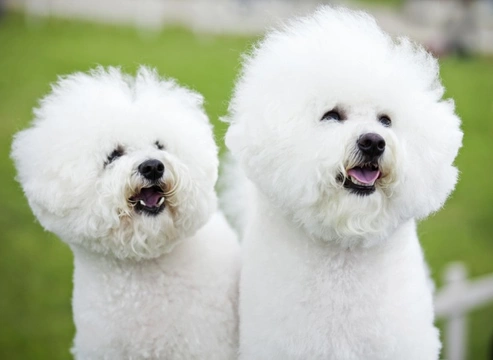
Common skin and coat problems in the Bichon Frise dog breed
The Bichon Frise is one of a number of popular small, white fluffy dog breeds that are common in the UK, and they are also often particularly popular among people who tend to otherwise suffer from allergies to dog dander, due to the wavy coat of the breed that sheds in very low quantities.
They are also versatile and loving, and fit well within all sorts of different lifestyles and types of homes, whether that be the large suburban home of a family or a more sedate retirement apartment with an older owner.
However, the Bichon Frise dog breed as a whole is one that tends to suffer from more than their fair share of skin and coat problems, which is somewhat ironic when you consider their popularity with people due to the lack of problems their skin and coats tend to cause for humans.
If you are considering buying or adopting a Bichon Frise, it is a good idea to appraise yourself of the most common skin and coat problems that can affect the breed, so that you can be sure that you are ready to tackle any issues that might arise and will have a good chance of recognising a problem in the making.
In this article, we will look at the most common coat and skin problems that can affect the Bichon Frise dog breed. Read on to learn more.
Sebaceous cysts
Sebaceous cyst development occurs when the sebum that the dog’s skin products clogs up their skin around hair follicles, causing congestion and cyst development along the follicle itself. These can easily be mistaken for an ingrown hair, but they won’t generally go away on their own and can be irritating and potentially painful for your dog.
It is important to note that you should not interfere with or try to treat sebaceous cysts on your dog at home – talk to your vet about how to proceed and don’t be tempted to pick or squeeze the cysts, as this may be painful and also, lead to the cyst becoming infected.
Flea bite sensitivity
The Bichon Frise breed as a whole tends to be more sensitive than most breeds to skin reactions to parasites, and they have an exponentially higher risk than most other dogs of developing flea bite sensitivity.
Flea bite sensitivity causes an acute localised reaction to occur in the region of every flea bite your dog gets, and so it is important to use an appropriate flea treatment on your dog and be consistent about applying it to the right schedule to prevent the problem from developing in the first place.
Allergies
The Bichon Frise also tends to be quite sensitive to developing allergies, including food sensitivities and various types of airborne and contact allergies that can affect the skin and coat. Getting to the bottom of any dog’s allergenic trigger can be very challenging, and may take some time as well as several visits to the vet – but there are also medications and lifestyle changes that your vet may be able to recommend to help to keep the effects of such allergies in check.
Injection site alopecia
Injection site alopecia is a rare and unusual condition that causes the dog in question to lose their fur in the area immediately surrounding the site of an injection. This most commonly means around the scruff of the neck, where your dog receives their annual booster shots – although it can of course affect other areas of the body if your dog is treated with injected medications for other conditions too.
The hair loss itself may take weeks or even months to develop, which means that it can be hard to make the connection between the injection site and later hair loss – but if this seems like a pattern for your dog, let your vet know about it.
Stress-related skin and coat problems
Stress and anxiety can have an acute and systemic effect on your dog’s health and wellness, as well as leading to their being distressed and unhappy. This can cause a dull, dry coat, dry, flaking skin, and a wide range of other coat and skin disorders that are apt to flare up at times of stress or upheaval.
Bichons are fairly sensitive dogs that don’t like to be left alone and require a regular routine to feel comfortable, and to help to ensure that they don’t become stressed and unhappy.
Follicular tumours
Finally, one particular skin and coat issue that can arise in mature and elderly Bichon Frise dogs is follicular tumours, or to give them their scientific name, calcifying epitheliomas, which are tiny tumours that develop around the hair follicles. If your dog suffers from sebaceous cysts, it is important to bear this in mind, as the two conditions can appear very similar at a glance.
However, such tumours don’t necessarily indicate the presence of cancer, and they may well be benign – but it is important to get your vet to check them out regardless, as they can be malignant, and to get to the root of the problem.



